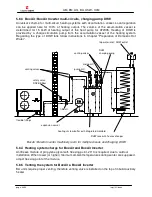
AM, EM, AQ, BA, ASW - IOM
page: 36/64
Ing.Ji
ř
í Jiránek
5 Connestion to the Heating System
The heat pump must be connected to a suitable, low-temperature heating system. From the
perspective of optimum efficiency the floor heating is ideal, then the wall heating, and the least
convenient are radiators dimensioned to temperature gradient, typically of 50/40°C, maximum
55/45°C. It is the responsibility of the architect, installation company, and the investor to choose
the type of heating system.
5.1 Heating System – WARNING
Heating system dimensioned on temperature gradient higher than 55/45°C cannot be
used for the heat pump. If the case is reconstruction of the boiler – machinery room,
technical expertise is required to determine if the heating system is suitable for usage
with the heat pump.
5.2 Water Quality -Hardness dH and pH value
Following requirements are valid according to the nominal capacity and relative volume:
Capacity kW (relative volume l/kW)
Maximum Hardness
dH
pH
value
<50kW (<20l/kW)
16
8-9
<50kW (>20l/kW)
11
8-9
>50<=200kW
11
8-9
>200<=600kW
8
8-9
>600kW
0.11
8-9
5.2.1 Corrosion Inhibitors
It is neccessary to check water quality before filling the system and add corrosion inhibitors.
Type of heating system components material muts be taken into consideration and use suitable
corrosion inhibitor. Concentration of corrosion inhibitors must be annually checked and refilled
when neccessary. To check inhibitor concentration, use indicators supplied by inhibitor
manufacturer/distributor.
Warning: When corrosion inhibitors are not used and dH/pH is not adjusted, metal
materials are dissolving into heating water. Dissolved metals are later sedimenting in
heat exchangers, flexible hoses, pumps and other components, causing possible
damage of the heat pump system. This kind of damage is EXCLUDED from warranty.
5.2.2 Bacterial and mould protection
In case of low temperature applications like UFH, typical for heat pumps, we recommend to use
antibacterial inhibitors as well.
















































